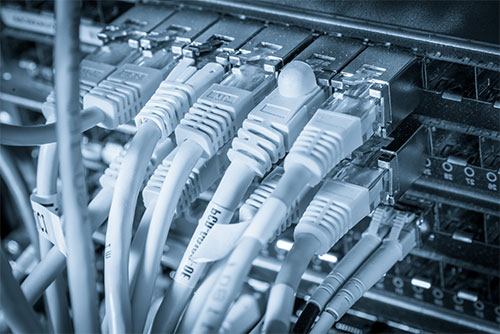 The ability to deliver video, data and power over Ethernet and coaxial cabling provides security professionals with an attractive solution for deploying highly-functional, networked systems with extreme cost-efficiency.
The ability to deliver video, data and power over Ethernet and coaxial cabling provides security professionals with an attractive solution for deploying highly-functional, networked systems with extreme cost-efficiency.
More importantly, IP over Ethernet products offer the unique ability to easily and efficiently utilize legacy coax infrastructure as the foundation for a networked system platform. New products provide even greater efficiency by accommodating multiple cameras over a single coax or Ethernet cable.
Making the PoE Connection
First used for voice-over-IP telephones, PoE technology provides power safely to network devices through the same CAT5 or higher cable that transmits Ethernet data. In security and surveillance systems, up to 15.4 watts can be supplied to network cameras and other devices using PoE (IEEE 802.3af), and up to 30 watts to power pan-tilt-zoom (PTZ) cameras, infrared (IR) illuminators, heaters and blowers, magnetic locks and other devices using PoE+ (IEEE 802.3at). If you plug a PoE+ device into a standard PoE switch or PoE midspan, the device will not operate. A “handshake” between PoE or PoE+ devices and the power source confirms the required standard before power is supplied to the device. An even higher-power PoE provides up to 60+ watts by using all four wire pairs in the cable versus the traditional two.
Using PoE eliminates the need to purchase and install additional cable to provide power to devices. They also don't have to use localized power, which can be even more expensive. PoE on the same cable with IP data lessens the probability of having video ground loop issues common with analog installations.
Troubleshooting PoE
Many integrators already understand and deploy PoE solutions; however, one common problem is that some existing PoE switches do not provide sufficient power due to the power requirements of the end-point devices. Even non-security devices, such as newer, feature-packed, IP telephones, may draw more power than would be supplied by a PoE switch. In such cases, a new switch is needed, or a PoE Midspan can solve the problem – and provide a potential new base of non-security customers to help dealer/installers expand their business. For security dealer/installers who already have business in the voice-over-IP arena, new PoE Midspan devices are an opportunity to upsell a more robust and dependable power supply to meet the higher-power needs of newer IP telephones.
PoE Midspans simplify power management and ensure system functionality. Other advantages include scalability and flexibility, such as cascading for longer distances, and the ability to easily match the power requirements for an edge device. They also ensure that power remains intact, even if a network connection is lost. For example, many IP cameras now can record images on an SD card as a backup in the event of a lost network connection, but the feature doesn't work if the camera's power supply is interrupted. With PoE Midspans, cameras can still be operational.
In addition, deploying managed midspans with remote access via an IP address makes installing, troubleshooting and servicing systems more efficient. These PoE Midspans allow technicians to ascertain how much power each end-point device is drawing, their maximum power draw and total power consumption, as well as the total maximum power consumption of all the devices connected to the midspan. Remote accessibility of the PoE Midspan ensures installers that they will never exceed the maximum output of the power supply.
Managed PoE Midspans also provide tools for finding possible power problems with installed devices. These midspans have the ability of automatically shutting down power to a port in the event a faulty device is pulling too much power or if there is a short. This simple feature allows service technicians to quickly diagnose and resolve problems that could otherwise take hours or even days. In the event a device just needs a simple reboot, remote access allows installers to perform reboot functions without sending a technician to the job site.
These and other remote features make integrators’ and dealers’ system set-up, service and maintenance much more efficient relative to the deployment of manpower in the field.
Transformation of Legacy Coax Cable
Ethernet over Coax Adapters continue to gain traction as the most cost-efficient means of migrating from an analog system platform to a networked system platform. It's less expensive to transmit Ethernet signals across existing coaxial cable with Ethernet over Coax Adapters than installing new structured cable. The labor to remove existing coax is also in addition to the cost of pulling the new structured cable. Ethernet over Coax Adapters provide a cost edge when bidding on a competitive job and could mean the difference in winning the job.
There are functional advantages as well. Coaxial cable can transmit Ethernet signals further than CAT cable without using repeaters, and they can transmit data at distances up to 1,500 feet (or five times farther) on RG-59u. It's a much less expensive option than the alternative of fiber cabling and fiber transceiver modules for longer distances. And, when you add in the ability to simultaneously deliver PoE and PoE+ over coaxial cable infrastructure, the cost-savings continue to add up by eliminating the equipment and labor expenses associated with installing localized power supplies.
Ethernet over Coax Adapters also provide additional bandwidth using a single cable, allowing multiple cameras to use one coax cable, hence, reducing costs. When using IP cameras with composite video outputs, some Ethernet over Coax Adapters can transmit both IP and composite video simultaneously ensuring that video is always present on the coax for monitoring and recording purposes.
All of these advantages add up to significant savings when migrating systems from an analog to an IP networked system platform while actually increasing system performance and coverage using state-of-the art, IP cameras and devices.